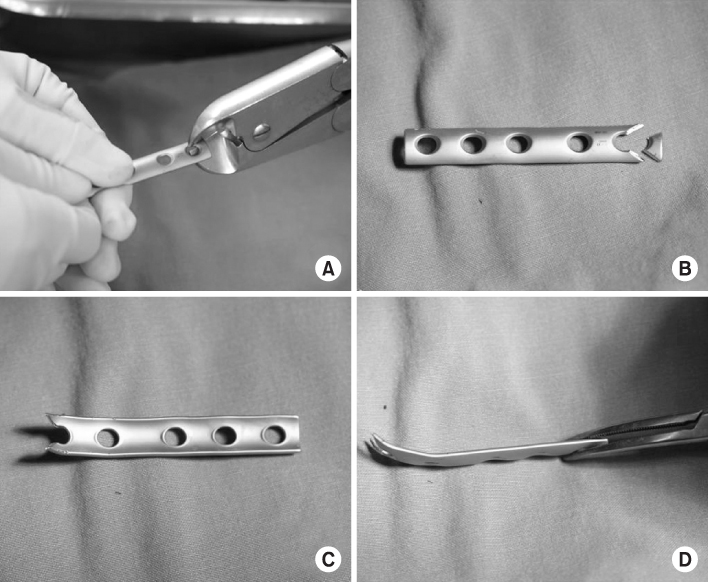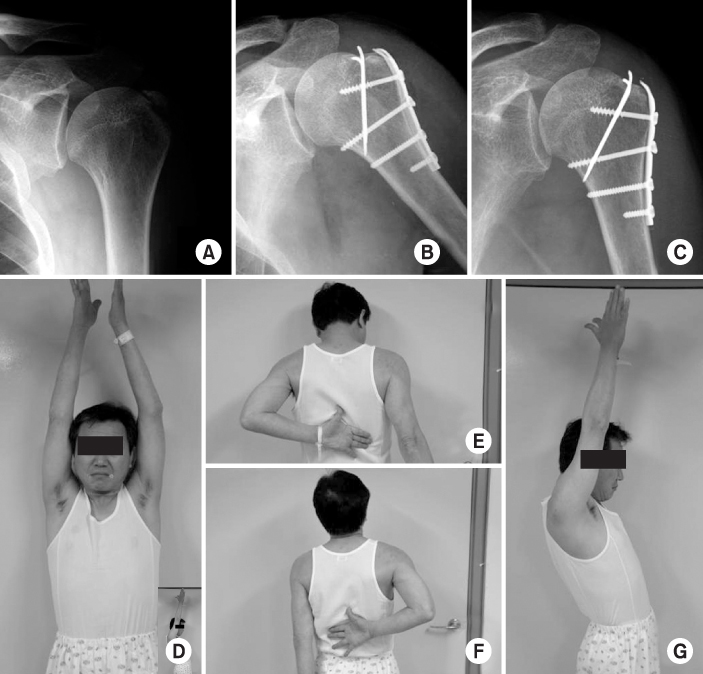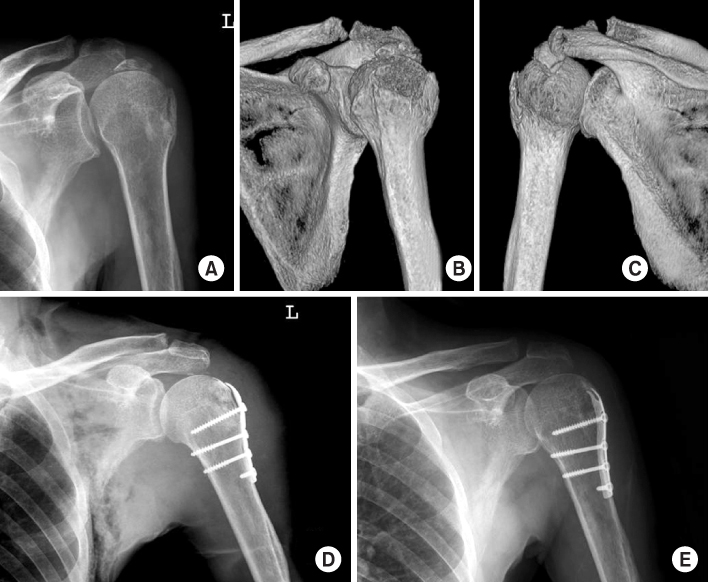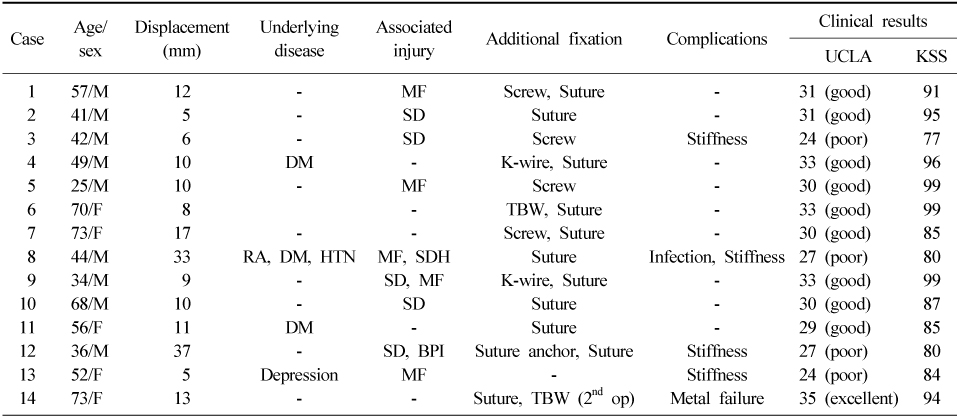Articles
- Page Path
- HOME > J Musculoskelet Trauma > Volume 22(3); 2009 > Article
-
Original Article
- The Surgical Outcomes of Isolated Greater Tuberosity Fractures of the Proximal Humerus Fixed with the Spring Plate
- Dong-Ju Shin, M.D., Young-Soo Byun, M.D., Se-Ang Chang, M.D., Hee-Min Yun, M.D., Ho-Won Park, M.D., Jae-Young Park, M.D.
-
Journal of the Korean Fracture Society 2009;22(3):159-165.
DOI: https://doi.org/10.12671/jkfs.2009.22.3.159
Published online: July 31, 2009
Department of Orthopedic Surgery, Daegu Fatima Hospital, Daegu, Korea.
- Address reprint requests to: Young-Soo Byun, M.D. Department of Orthopaedic Surgery, Daegu Fatima Hospital, 576-31, Sinam-dong, Dong-gu, Daegu 701-600, Korea. Tel: 82-53-940-7320, Fax: 82-53-940-7417, fatimaos@unitel.co.kr
Copyright © 2009 The Korean Fracture Society. All rights reserved.
This is an Open Access article distributed under the terms of the Creative Commons Attribution Non-Commercial License (http://creativecommons.org/licenses/by-nc/3.0/) which permits unrestricted non-commercial use, distribution, and reproduction in any medium, provided the original work is properly cited.
- 548 Views
- 2 Download
- 1 Crossref
Abstract
-
Purpose
- The purpose of this study was to evaluate the surgical outcomes of isolated greater tuberosity fractures of the proximal humerus fixed with the spring plates.
-
Materials and Methods
- Fourteen patients who could be followed up at least 1 year after the surgical treatment of isolated greater tuberosity fracture were evaluated. Their mean age was 51 years (range, 25~73 years). The deltopectoral approach and fixation with the spring plate were performed in all cases. The spring plate was used in all cases. In some circumstances, sutures incorporating the rotator cuff, interfragmentary screw or tension band wire were added. We evaluated the clinical outcomes using UCLA scoring system and KSS (Korean Shoulder Score).
-
Results
- The mean UCLA score was 29.8 and the mean KSS was 89.4. The average time of bony union was 10.2 weeks (range, 7~14 weeks) after the surgery, including 1 case that was performed the secondary operation due to metal failure. The shoulder stiffness were observed in 4 cases and one case of infection was treated well without operation.
-
Conclusion
- In the treatment of isolated greater tuberosity fractures of the proximal humerus, the spring plates fixation can be a good surgical option providing reliable functional results.
- 1. Bono CM, Reonard R, Levine RG, Levy AS. Effect of displacement of fractures of the greater tuberosity on the mechanics of the shoulder. J Bone Joint Surg Br, 2001;83:1056-1062.ArticlePDF
- 2. Brien WW, Gellman H, Becker V, Garland DE, Waters RL, Wiss DA. Management of fractures of the humerus in patients who have an injury of the ipsilateral brachial plexus. J Bone Joint Surg Am, 1990;72:1208-1210.Article
- 3. Chun JM, Kim SY, Oh SK, Kim JH, Choi JH. Deltopectoral approach for the operative treatment of fracture of the greater tuberosity of the proximal humerus. J Korean Soc Surg Hand, 2003;8:28-32.
- 4. Constant CR, Murley AH. A Clinical method of functional assessment of the shoulder. Clin Orthop Relat Res, 1987;214:160-164.Article
- 5. Flatow EL, Cuomo F, Maday MG, Miller SR, Mcllveen SJ, Bigliani LU. Open reduction and internal fixation of two-part displaced fractures of the greater tuberosity of the proximal part of the humerus. J Bone Joint Surg Am, 1991;73:1213-1218.Article
- 6. Green A, Izzi J. Isolated fractures of the greater tuberosity of the proximal humerus. J Shoulder Elbow Surg, 2003;12:641-649.Article
- 7. Han SB, Park SW, Lee SH, Chung JW, Choi GW. The use of spring plates in management of acetabular posterior wall fractures. J Korean Hip Soc, 2005;17:217-222.
- 8. Haryman DT II. Common surgical approaches to the shoulder In instructional course lectures. The America academy of orthopaedic surgeons. 3rd ed. Philadelphia: Harper Row; 1982. p. 309.
- 9. Iannotti JP, Garbriel JP, Schneck SL, Evans BG, Misra S. The normal glenohumeral relationships. An anatoimical study of on hundred and forty shoulders. J Bone Joint Surg Am, 1992;74:491-500.
- 10. Ihn JC, Kim PT, Shin DK. Hooked spring plate: its uses in posterior wall acetabular fracture fixation. J Korean Soc Fract, 1994;7:606-615.Article
- 11. Ji JH, Kim YY, Kim WY, Park SE, Ra KH, Do JH. Arthroscopic treatment of greater tuberosity fracture-Preliminary Report-. J Korean Orthop Soc Sports Med, 2007;6:57-65.
- 12. Kim E, Shin HK, Kim CH. Characteristics of an isolated greater tuberosity fracture of the humerus. J Orthop Sci, 2005;10:441-444.Article
- 13. Keen WW. I. Fracture of the greater tuberosity of the humerus, with dislocation of the humerus into the axilla. Immediate reduction of dislocation. On seventh day nailing of fragment of tuberosity in place. Ann Surg, 1907;45:938-944.Article
- 14. Lee KJ, Choi CH, Kim JM, et al. The Shoulder and elbow. 1st ed. Seoul, Korea: Young-Chang; 2007. p. 676-679.
- 15. Lee KJ, Choi CH, Kim JM, et al. The Shoulder and elbow. 1st ed. Seoul, Korea: Young-Chang; 2007. p. 290-291.
- 16. McLaughlin HL. Dislocation of the shoulder with tuberosity fracture. Surg Clin North Am, 1963;43:1615-1620.Article
- 17. Moon ES, Kim MS, Kim YJ. The surgical outcomes for isolated greater tuberosity fracture of proximal humerus. J Korean Fract Soc, 2007;20:239-245.Article
- 18. Neer CS 2nd. Displaced humeral fractures. II. Treatment of three-part and four-part displacement. J Bone Joint Surg Am, 1970;52:1090-1103.
- 19. Neer CS 2nd. Displaced proximal humeral fractures. I Classification and evaluation. J Bone Joint Surg Am, 1970;52:1077-1089.
- 20. Olivier H, Dupare G, Romain F. Fractures of the greater tuberosity of the humerus. Orthop Trans, 1986;10:223.
- 21. Park MC, Murthi AM, Roth NS, Blaine TA, Levine WN, Bigliani LU. Two-part and three-part fractures of the proximal humerus treated with suture fixation. J Orthop Trauma, 2003;17:319-325.Article
- 22. Park TS, Choi IY, Kim YH, Park MR, Shon JH, Kim SI. A new suggestion for the treatment of minimally displaced fractures of the greater tuberosity of the proximal humerus. Bull Hosp Jt Dis, 1997;56:171-176.
- 23. Park TS, Kim TS, Park YS, Kim DH, Kang CN, Whang KS. The treatment of one-part fractures of the greater tuberosity of the proximal humerus. J Korean Shoulder Elbow Soc, 1999;2:21-27.
- 24. Crichlow RJ, Andres PL, Morrison SM, Haley SM, Vrahas MS. Depression in orthopaedic trauma patients. Prevalence and severity. J Bone Joint Surg Am, 2006;88:1927-1933.
- 25. Santee HE. Fractrues about the upper end of humerus. Ann Surg, 1924;80:103-114.
REFERENCES



Figure & Data
REFERENCES
Citations

- Outcomes of open reduction and internal fixation using 2.0/2.4 mm locking compression plate in isolated greater tuberosity fractures of humerus
Sung Choi, Dongju Shin, Sangwoo Kim, Byung Hoon Kwack
Journal of Musculoskeletal Trauma.2025; 38(1): 32. CrossRef



Fig. 1
Fig. 2
Fig. 3
Patient demographics
M: Male, F: Female, DM: Diabetus mellitus, RA: Rheumatoid arthritis, HTN: Hypertension, MF: Multiple fracture, SD: Shoulder dislocation, SDH: Subdural hemorrhage, BPI: Brachial plexus injury, TBW: Tension band wire.
M: Male, F: Female, DM: Diabetus mellitus, RA: Rheumatoid arthritis, HTN: Hypertension, MF: Multiple fracture, SD: Shoulder dislocation, SDH: Subdural hemorrhage, BPI: Brachial plexus injury, TBW: Tension band wire.

 E-submission
E-submission KOTA
KOTA TOTA
TOTA TOTS
TOTS

 Cite
Cite

